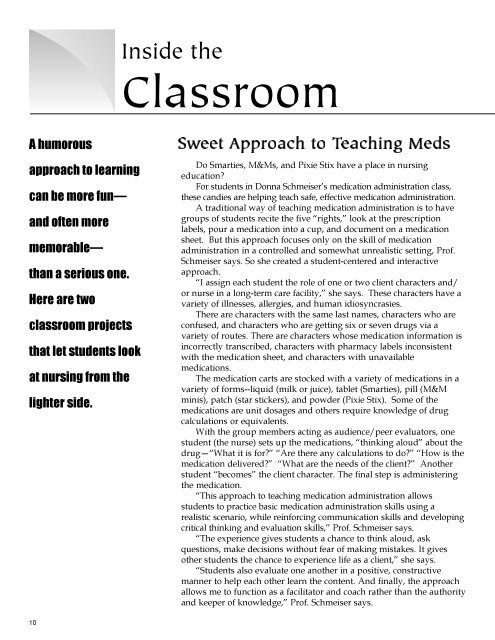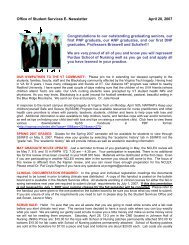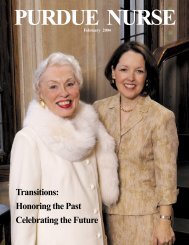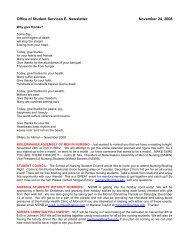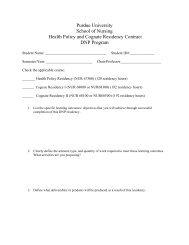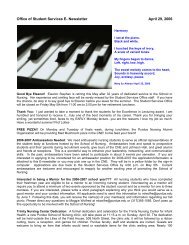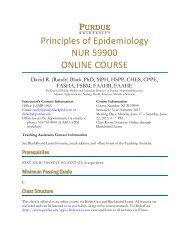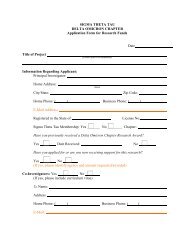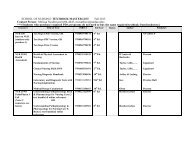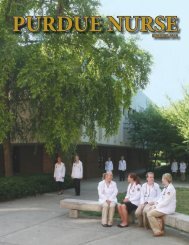Purdue Nurse - Summer 2001 - School of Nursing - Purdue University
Purdue Nurse - Summer 2001 - School of Nursing - Purdue University
Purdue Nurse - Summer 2001 - School of Nursing - Purdue University
You also want an ePaper? Increase the reach of your titles
YUMPU automatically turns print PDFs into web optimized ePapers that Google loves.
Inside the<br />
Classroom<br />
A humorous<br />
approach to learning<br />
can be more fun—<br />
and <strong>of</strong>ten more<br />
memorable—<br />
than a serious one.<br />
Here are two<br />
classroom projects<br />
that let students look<br />
at nursing from the<br />
lighter side.<br />
Sweet Approach to Teaching Meds<br />
Do Smarties, M&Ms, and Pixie Stix have a place in nursing<br />
education?<br />
For students in Donna Schmeiser’s medication administration class,<br />
these candies are helping teach safe, effective medication administration.<br />
A traditional way <strong>of</strong> teaching medication administration is to have<br />
groups <strong>of</strong> students recite the five “rights,” look at the prescription<br />
labels, pour a medication into a cup, and document on a medication<br />
sheet. But this approach focuses only on the skill <strong>of</strong> medication<br />
administration in a controlled and somewhat unrealistic setting, Pr<strong>of</strong>.<br />
Schmeiser says. So she created a student-centered and interactive<br />
approach.<br />
“I assign each student the role <strong>of</strong> one or two client characters and/<br />
or nurse in a long-term care facility,” she says. These characters have a<br />
variety <strong>of</strong> illnesses, allergies, and human idiosyncrasies.<br />
There are characters with the same last names, characters who are<br />
confused, and characters who are getting six or seven drugs via a<br />
variety <strong>of</strong> routes. There are characters whose medication information is<br />
incorrectly transcribed, characters with pharmacy labels inconsistent<br />
with the medication sheet, and characters with unavailable<br />
medications.<br />
The medication carts are stocked with a variety <strong>of</strong> medications in a<br />
variety <strong>of</strong> forms--liquid (milk or juice), tablet (Smarties), pill (M&M<br />
minis), patch (star stickers), and powder (Pixie Stix). Some <strong>of</strong> the<br />
medications are unit dosages and others require knowledge <strong>of</strong> drug<br />
calculations or equivalents.<br />
With the group members acting as audience/peer evaluators, one<br />
student (the nurse) sets up the medications, “thinking aloud” about the<br />
drug—“What it is for?” “Are there any calculations to do?” “How is the<br />
medication delivered?” “What are the needs <strong>of</strong> the client?” Another<br />
student “becomes” the client character. The final step is administering<br />
the medication.<br />
“This approach to teaching medication administration allows<br />
students to practice basic medication administration skills using a<br />
realistic scenario, while reinforcing communication skills and developing<br />
critical thinking and evaluation skills,” Pr<strong>of</strong>. Schmeiser says.<br />
“The experience gives students a chance to think aloud, ask<br />
questions, make decisions without fear <strong>of</strong> making mistakes. It gives<br />
other students the chance to experience life as a client,” she says.<br />
“Students also evaluate one another in a positive, constructive<br />
manner to help each other learn the content. And finally, the approach<br />
allows me to function as a facilitator and coach rather than the authority<br />
and keeper <strong>of</strong> knowledge,” Pr<strong>of</strong>. Schmeiser says.<br />
10


